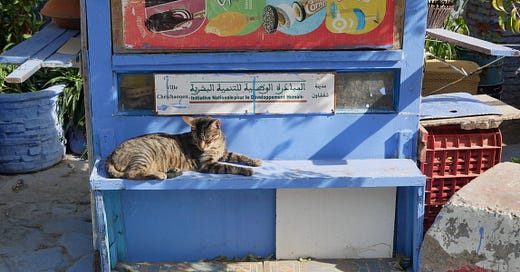Morocco is unlike any other destination I’ve been to. The moment you step off the car, your senses are overwhelmed by the donkeys sharing the roads with you, the constant bustle, cats that beg for food at every meal, the dry heat, the prayer calls, and the assault of colours and patterns. It’s not the easiest place to be a traveller but there’s so much to love - the masterful way in which the locals use spices, the abundance of fig trees, and the sense of hospitality… not to mention the culture of drinking mint tea (which was a dream for a non-coffee and -alcohol drinker like me!) As a Singaporean, going to Morocco was an incredible experience that opened my eyes to the Arabic influences on Singaporean food and culture. We landed in Tangier from the Netherlands and drove our way to Marrakesh, spending time in Chefchaouen, Fes, Meknes, Rabat, Casablanca, and Aït Benhaddou. Because friends and followers on IG were intrigued by our trip and are considering a visit to Morocco themselves, here is a round up of all our favourite bites and moments in between.
Favourite bites in Morocco
Restaurant Bab Ssour (Chefchaouen) - This was the best meal of our trip - everything we ordered was faultless. We had taktouka (charred peppers and tomatoes); hergma, a comforting braise of calf’s foot and chickpeas with saffron and turmeric which reminded me of the cap i pota (calf head and foot stew) that we enjoyed in Barcelona in 2022; lamb tagine with prunes which managed to be succulent and not at all dry; and yoghurt topped with fig jam and bee pollen. The bill came up to 12.50 euros for both of us, which I still can’t wrap my head around. More pictures from this meal here.
Restaurant Le Jardin Chez Ahmed (Taddarte) - Tagines are no doubt one of Morocco’s greatest culinary contributions to the world. The term refers to both the prepared dish and the vessel in which it is cooked. The ingredients are combined with a small amount of liquid in the clay cookware and set over a charcoal stove, allowing steam to build up - the food within thus simultaneously steams and braises. We had an incredible vegetable tagine at this roadside eatery, where a single morsel of chicken was nestled within layers of vegetables. Reflecting the Moroccan philosophy of first eating the vegetables before the meat, one unfurls the layers of potato, tomatoes, peppers, and carrots like the petals of a flower before the treasure in the centre is accessed - the chicken flavouring it all.
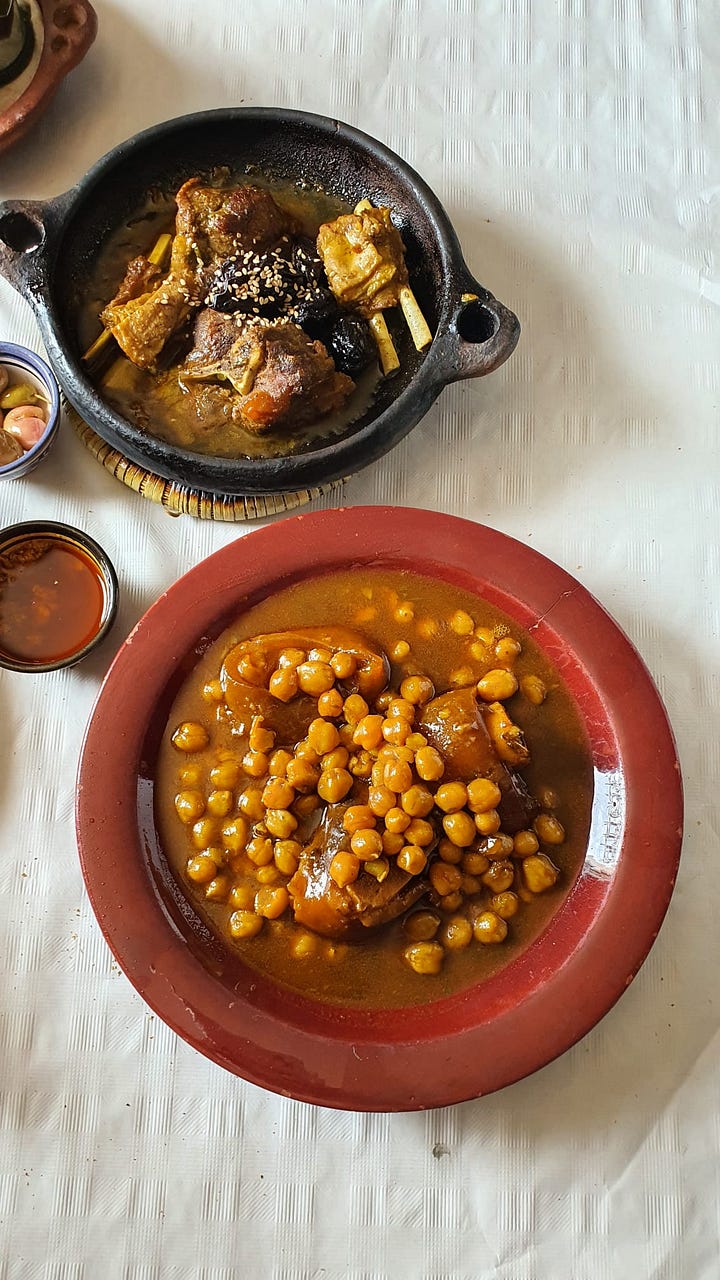
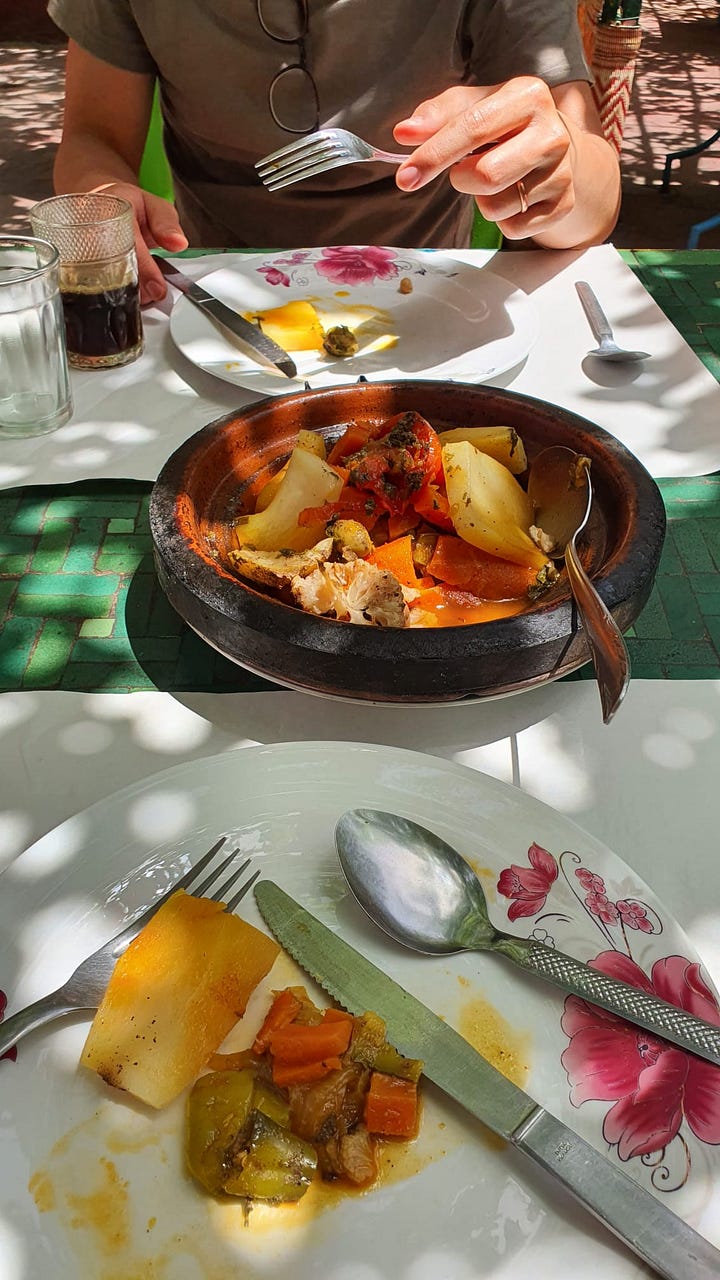
Restaurant Dar Baraka (Meknes) - We thought that the taktouka at Restaurant Bab Ssour couldn’t be beat, and then we tried the taktouka at Restaurant Dar Baraka. With nothing but charred peppers and tomatoes cooked in a generous trickle of olive oil, garlic, and spices, this was such a triumph of a vegetable dish that we didn’t quite care for the camel meat kofta that we also ordered (though it was very good).
Les Mystères de Dar Tajine (Fes) - We’ve tasted chicken pastilla at a Moroccan food stall at the Antwerp Saturday Market, but were itching to taste the real deal in Fes, the birth city of this pastry. The paper-thin pastry is made in a similar fashion to the wheat-based popiah wrappers that we enjoy in Singapore - by smearing dough over a hot pan before peeling it off. The pastry crackled thoroughly without a trace of sogginess, and the filling of chicken, pistachios, and roasted almonds toed the line between sweet and savoury brilliantly. The perfect between-meals snack.
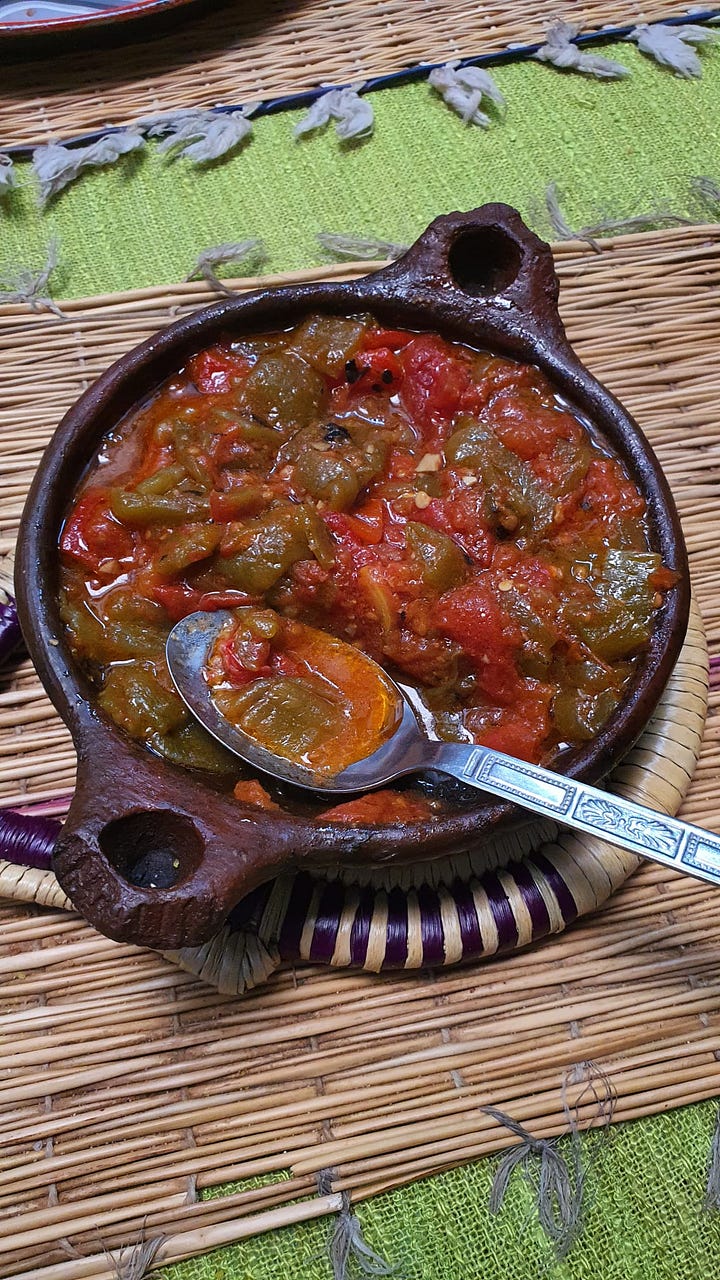
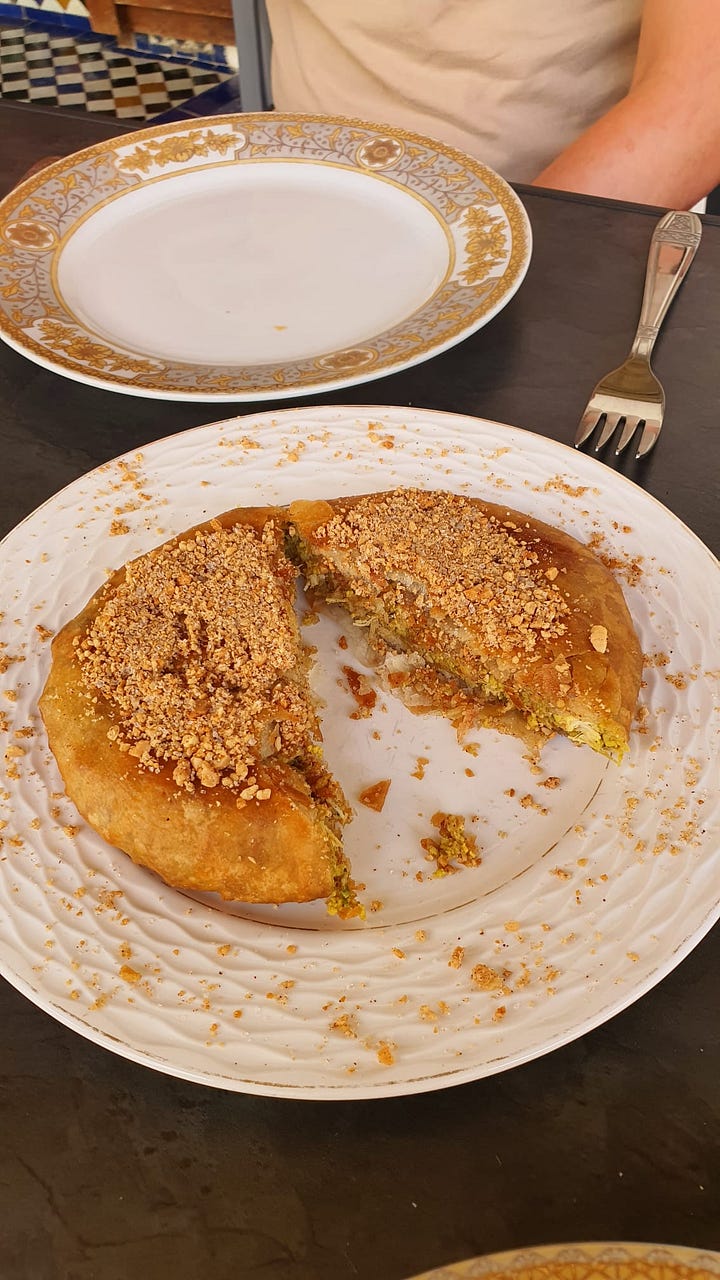
Bacha Coffee (Marrakesh) - Visiting Bacha Coffee is like stepping into a world of colonial charm and immaculate, napkin-arranged gentility. The coffee room enjoys an almost symbiotic relationship with the Dal el Bacha Palace in which it is located - when the coffee room is full, waiting patrons browse the surrounds until the electronic tag that you’re given beeps. The coffee menu (both caffeinated and decaffeinated) is extensive, and your order comes with vanilla bean whipped cream and a chocolate grinder instead of the usual complimentary sugar cubes and milk. An indulgence that is worth the wait.
Stall on the main street of the Old Market (Rabat) - Heads are one of my favourite parts of an animal to eat - it makes the most of a life that has been taken, and is one of the most succulent and meltingly tender cuts. All across Morocco, we’ve seen beef heads steamed in huge cauldrons, either on their own or buried within translucent threads of saffron-tinted vermicelli. At the main street of the Old Market in Rabat, we enjoyed a beef head sandwich which cost only 1.50 euros. As with the suckling pig head sandwich we had in Portugal, it was deliriously messy and over-the-top good. The Rabat market is also great for shopping (it has lowest priced goods we’ve seen, the tourist mark-up isn’t as crazy) and there’re Senegalese eateries if you’re wanting something other than Moroccan food.
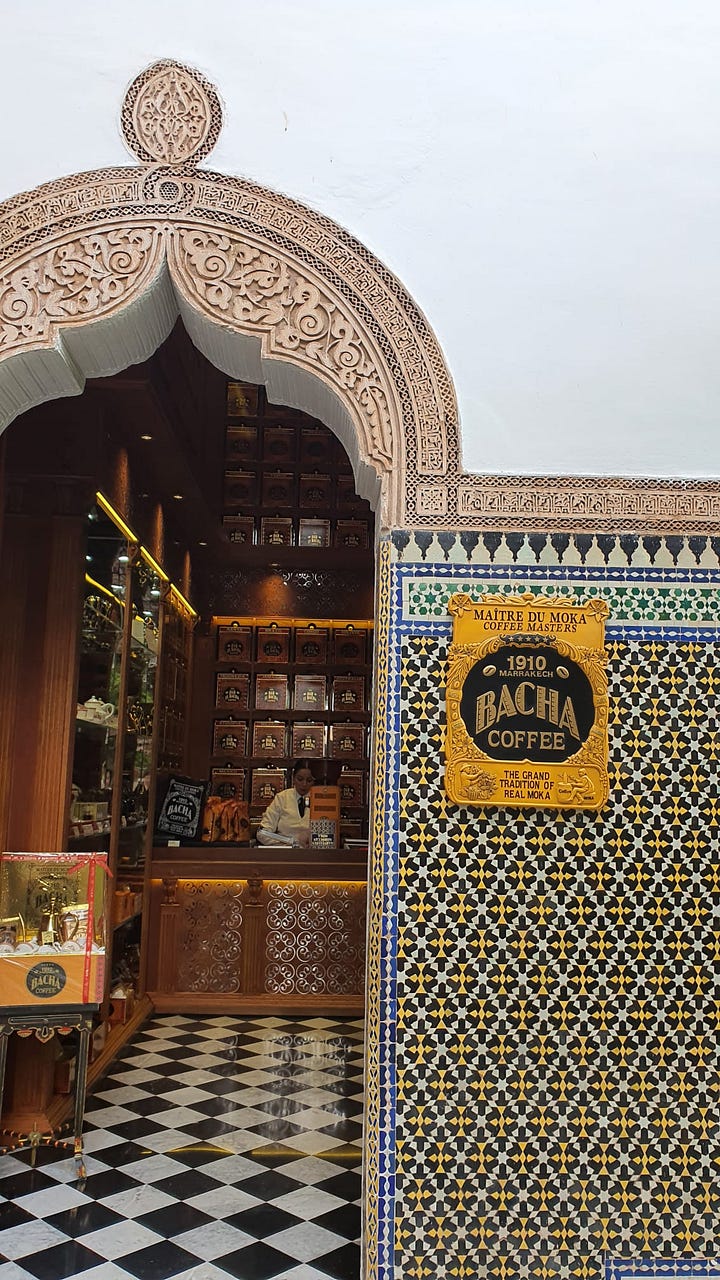

Experiences I’d recommend:
Chouara tannery or Tanneries de Fes (Fes) - Visiting Morocco can be confronting in many ways and visiting the tanneries in Fes, a city known for its leather products, made me question the human cost of the industry. Clutching onto bunches of mint to cope with the smell, we walked past artisans who were hard at work but nevertheless were so friendly towards us, and climbed a few flights of stairs to get a bird’s eye view of two tanneries. There, we took in the process of submerging raw hides in cow urine or a mixture of pigeon poop and water - the ammonia in excrement softens the leather and allows it to absorb dyes. Historically in Morocco, natural dyes such as pomegranate, turmeric, and indigo are used. I left with a deeper appreciation for the leather pieces that I own, for the craft, and for the sacrifice.
Hassan II Mosque (Casablanca) - If you’ve admired the intricate stonework of cathedrals in Europe, the mosques in Morocco are as breathtaking for their precise geometry and fusion of nature, spirituality, and architecture. We learnt during the guided tour (compulsory with your visit) that come Ramadan, water flows from the lotus leaf-shaped fountains in the underground ablution halls for believers to wash themselves. Above these halls, on the ground level, translucent basins fitted into the floor will be flooded with water to serve more people. In these moments, the spectacularly carved roof can be opened to achieve a confluence of the three elements of water, air, and land, making for a truly transcendent experience.

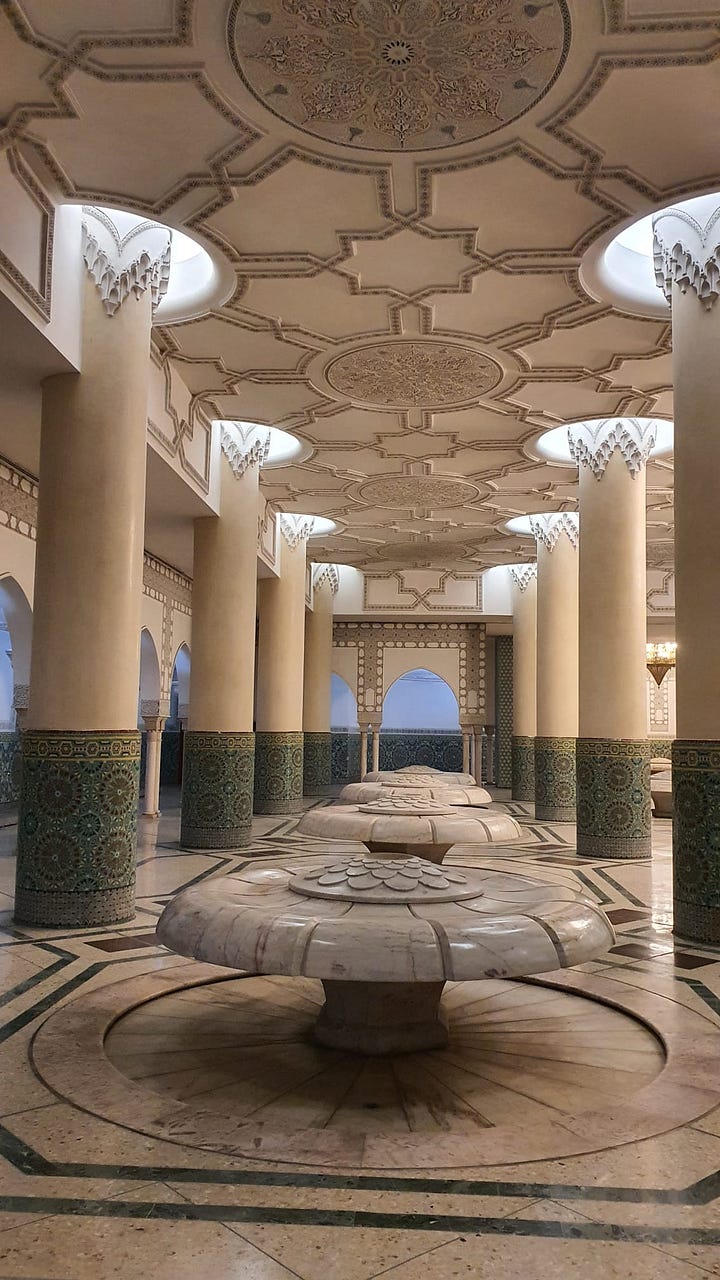
Aït Benhaddou - Wex and I have just started watching Game of Thrones a month ago and were thrilled to learn that one of the shooting venues was at Aït Benhaddou, a small village along the former caravan route between the Sahara and Marrakesh. There wasn’t much to do at Aït Benhaddou apart from visiting the top of the village to have a panoramic view, but if you enjoy long scenic drives, the road from Marrakesh to Ait Bennadou is a spectacular one. This was a highlight for Wex.
Site Archéologique de Volubilis (Meknes) - A UNESCO historical landmark of a Roman city dating back to the 1st Century AD. With or without a guide, you can stroll through the ruins and admire the intricately decorated columns, the triumphal arch, and the ornate mosaics.
Miscellaneous information
- Safety and other considerations
- Tips on navigating, driving and parking, language, budget, climate, religious considerations, shopping
Safety and other considerations
Morocco is not more dangerous than any other developing country, but neither is it the most comfortable destination for a traveller. If you have a young child or baby to care for, you can still have a pleasant trip if you pay more by hiring a guide or tipping the locals for their help. Otherwise, I recommend skipping a hectic city like Fes and spending more time at places such as Chefchaouen or Essaouira. We didn’t get to visit the latter on this trip, but Chefchaouen was my favourite city of all that we visited. The Jews who fled Nazi persecution in the 1930s painted the buildings and trees blue and it became the city’s trademark. There are postcard-perfect views at every turn (more photos here) and some say that the blue has a calming effect on people - it’s undisputed that the pace of life is far more relaxed here compared to the frenetic energy of Fes and Marrakesh. I never felt safer in Morocco than when I was in Chefchaouen. That said, if you stay in one place, you’d be missing out on so much of what Morocco has to offer and its regional specialities - such as the pastillas of Fes and the tangia of Marrakesh.
The most challenging parts of our trip were:

